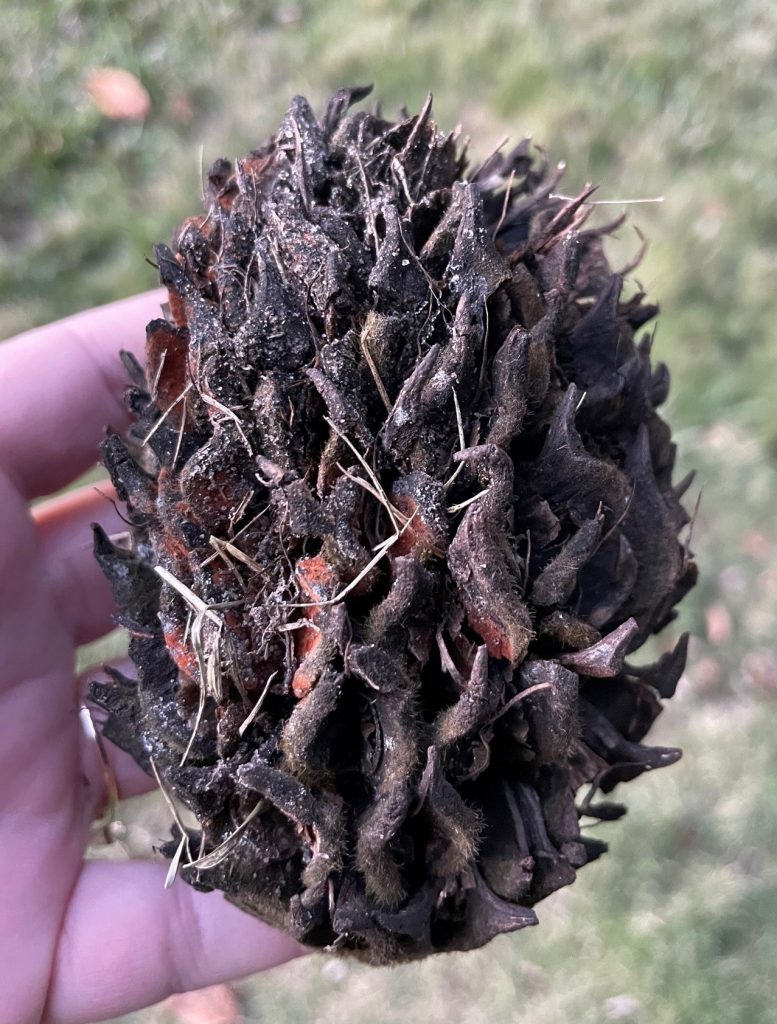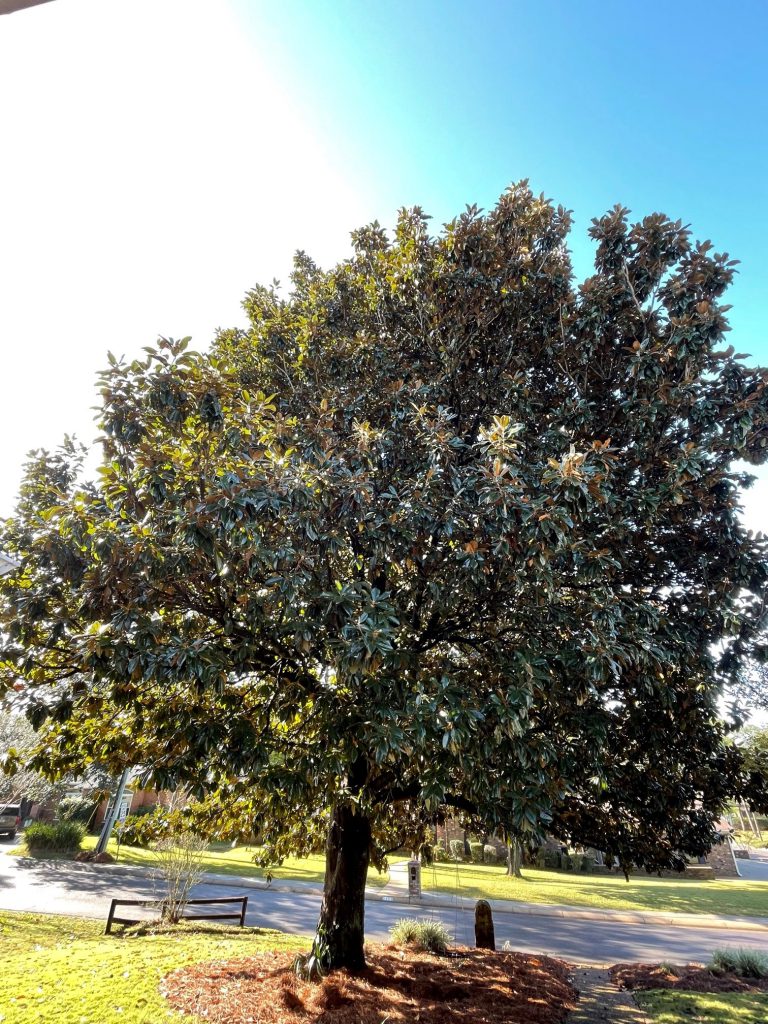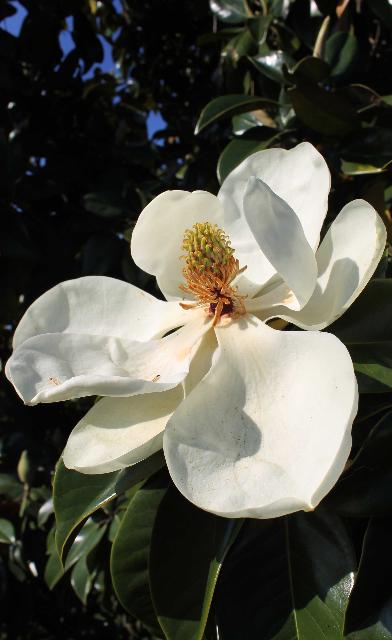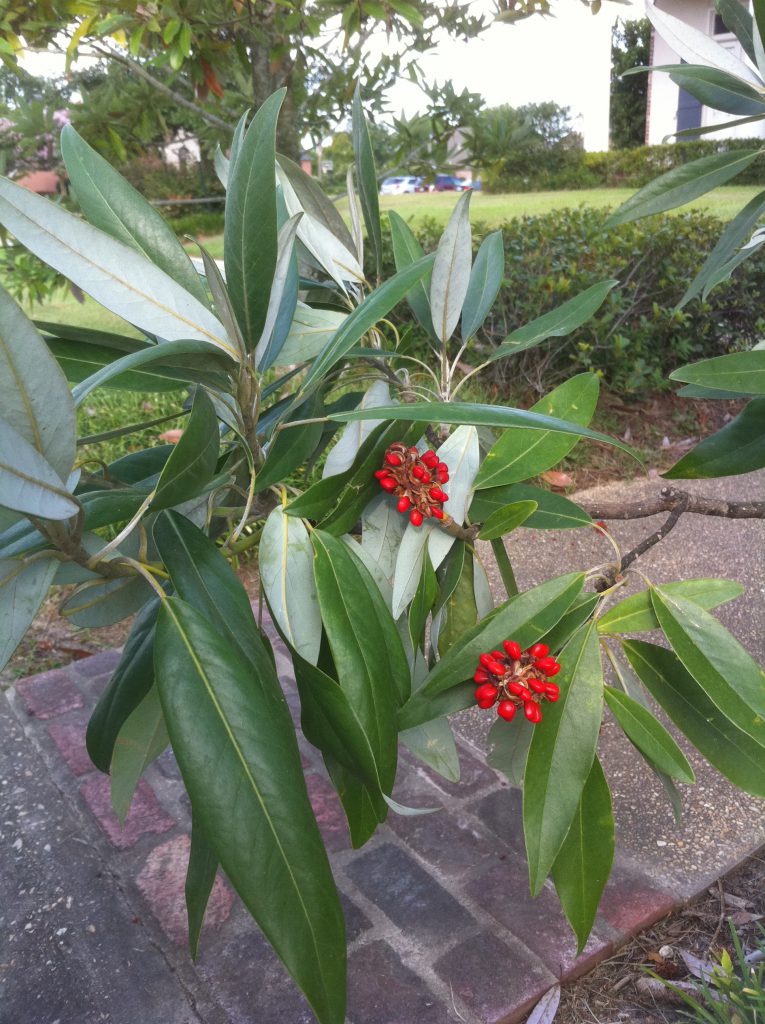About a year ago, one of my regular blog readers asked if magnolia trees (Magnolia grandiflora) had any particularly redeeming qualities. The one in her yard was constantly dropping leaves and seedpods, and she was tired of it. Little did she know, she had stepped into the domain of an absolute devotee of the magnolia tree. I told her that as a child of the Magnolia State (Mississippi) with the new magnolia-centered state flag flying from my front porch, it was my sworn duty to defend this magnificent symbol of southernness. Well, maybe I wasn’t so dramatic, but I definitely took on the challenge.

First, I do empathize with the constant leaf dropping. We have a large, beautiful magnolia tree in our front yard, and it drops its thick leaves year-round. We just rake them into a natural mulch pile around the base of the tree, though. As for the seedpods—those I have learned to be wary of. A couple of summers ago as I walked to my mailbox, I didn’t see one on the curb, then promptly rolled my ankle on it and landed face-first onto the road. After massive swelling and bruising on my foot, I finally went to a doctor to discover I’d managed to tear a tendon. So, tread carefully around the dropping seedpods!

But aside from that, it’s all positives. A Southern magnolia is as sturdy a tree as you could hope for—it is consistently ranked as one of the most wind-resistant trees in the landscape. Their thick, dense, upright trunks and the overall pyramidal shape allows the wind to whip around them, rarely causing damage. In fact, the only damage we’ve had to our tree was when a weaker tree fell on our magnolia and knocked some branches off. Eighteen years after Hurricane Ivan, it’s filled in and you’d never know it lost branches. Ours was planted 50 years ago to celebrate the birth of the previous homeowners’ son, and has been a source of shade and relaxation (we have a great swing hanging from it) ever since.

Like many other trees, magnolias have medicinal uses. The bark of a related magnolia species has been used in traditional Asian medicine to treat “anxiety, asthma, depression, gastrointestinal disorders, headache, and more” and our North American varieties were once used as an antimalarial drug. Modern research has shown seed extracts are effective in maintaining sleep and body temperature, as a sedative, and in reducing the intensity of epileptic seizures. As always, never attempt to use a plant-based home remedy without consulting a physician!
To me, nothing quite says springtime like a magnolia blossom. As buds, they are thick and velvety, completely covering the trees with pops of bright white. Once they bloom, these large (up to 8” wide) saucer-shaped blossoms give off a lovely fragrance, attracting pollinators. Interestingly, magnolias are such an ancient species that they evolved (in the Cretaceous period) before flying insects like bees and butterflies existed. Therefore, magnolias are pollinated by flies and flightless beetles, which crawl from one flower to the other, relying on their sense of smell to guide them. Because beetles are chewers, the flowers and leaves co-evolved to be thicker and tougher to offset and survive the bugs’ messy eating habits. Once the flowers have gone, the fuzzy grenade-shaped cones/seedpods grow on the trees. After the seedpods fall, they open to reveal brilliant red seeds. These have significant wildlife value, as songbirds, squirrels, deer, wild turkey, and quail eat the seeds. This time of year, many people use the waxy, deep green leaves for seasonal décor—magnolia wreaths are quite popular, especially in the south. Many people make their own, but companies often sell them for hundreds of dollars apiece!
In our area, the Southern magnolia is only one of several beautiful native specimens of the Magnolia genus. In freshwater wetlands, the slightly more petite sweet bay (Magnolia virginiana) is easily recognizable by the backs of its leaves, fluttering a silvery gray in the wind. One of my very favorite trees is the bigleaf magnolia (Magnolia macrophylla) which boasts mind-boggling leaves that can be over 2 feet long! In his travels throughout the United States in the late 18th century, explorer and naturalist William Bartram described the leaves as “an expanded umbrella, superbly crested with a silver plume.”

Magnolias may be so common as to seem unremarkable to many, but they are a hardy group of trees who have survived on the planet since dinosaurs roamed the earth. And that’s about as redeeming a quality as you can get. To learn about other magnolia varieties that work well in our area, check out this publication from UF IFAS Gardening Solutions.
- Wax Myrtle–a Native Evergreen - December 26, 2025
- Yucca–A Tough and Versatile Native Plant - November 26, 2025
- Blazing Star - November 6, 2025

